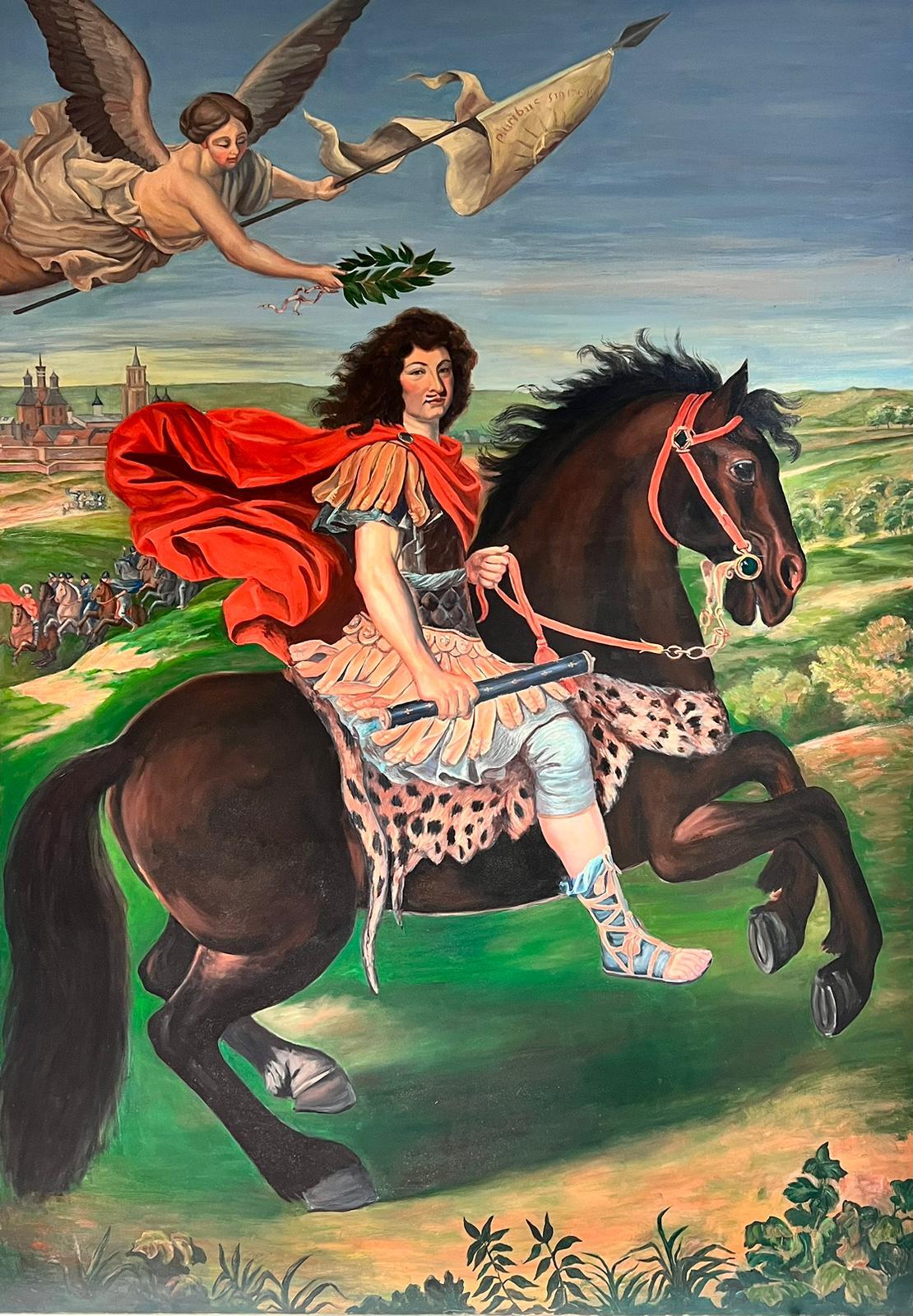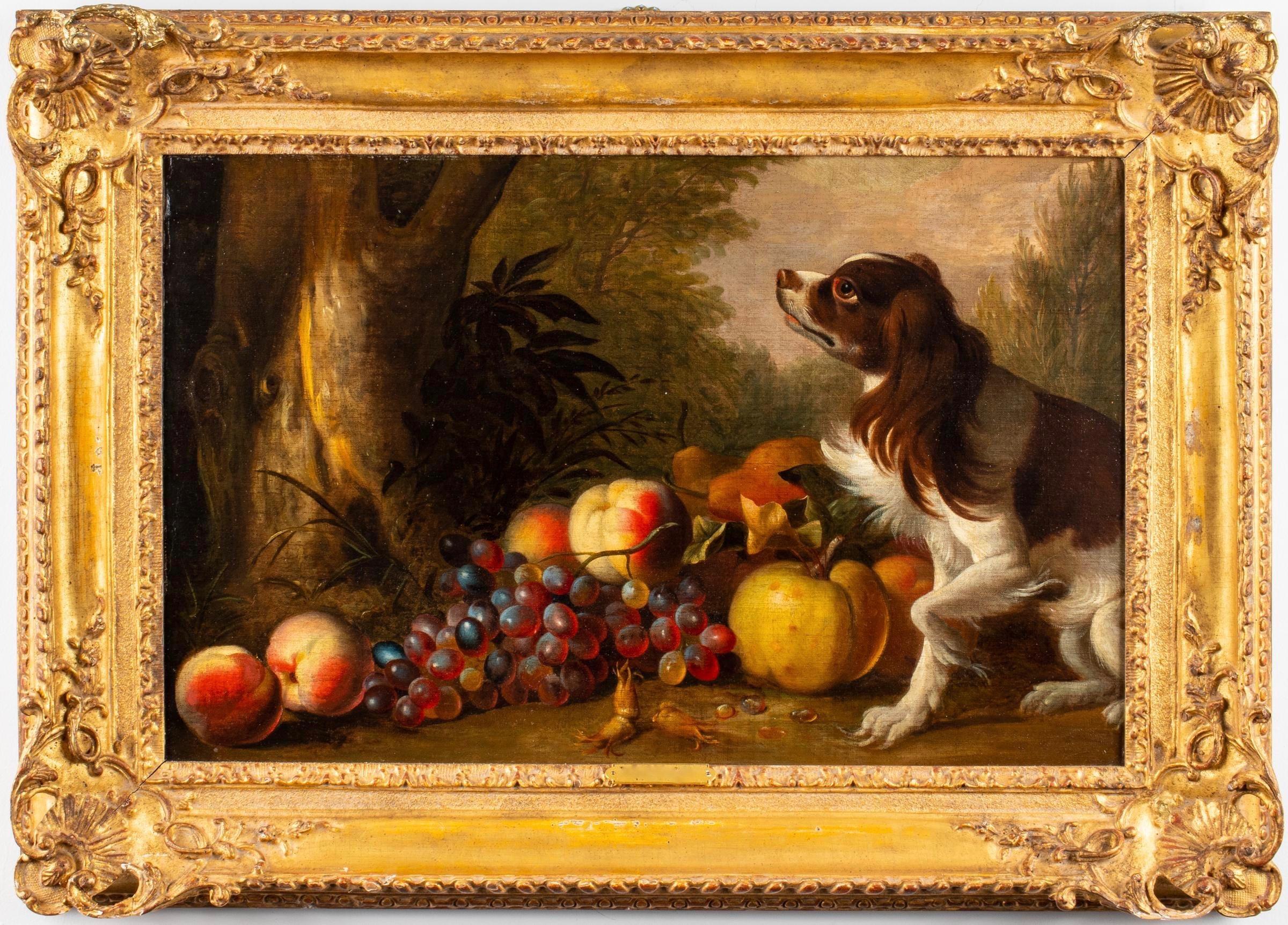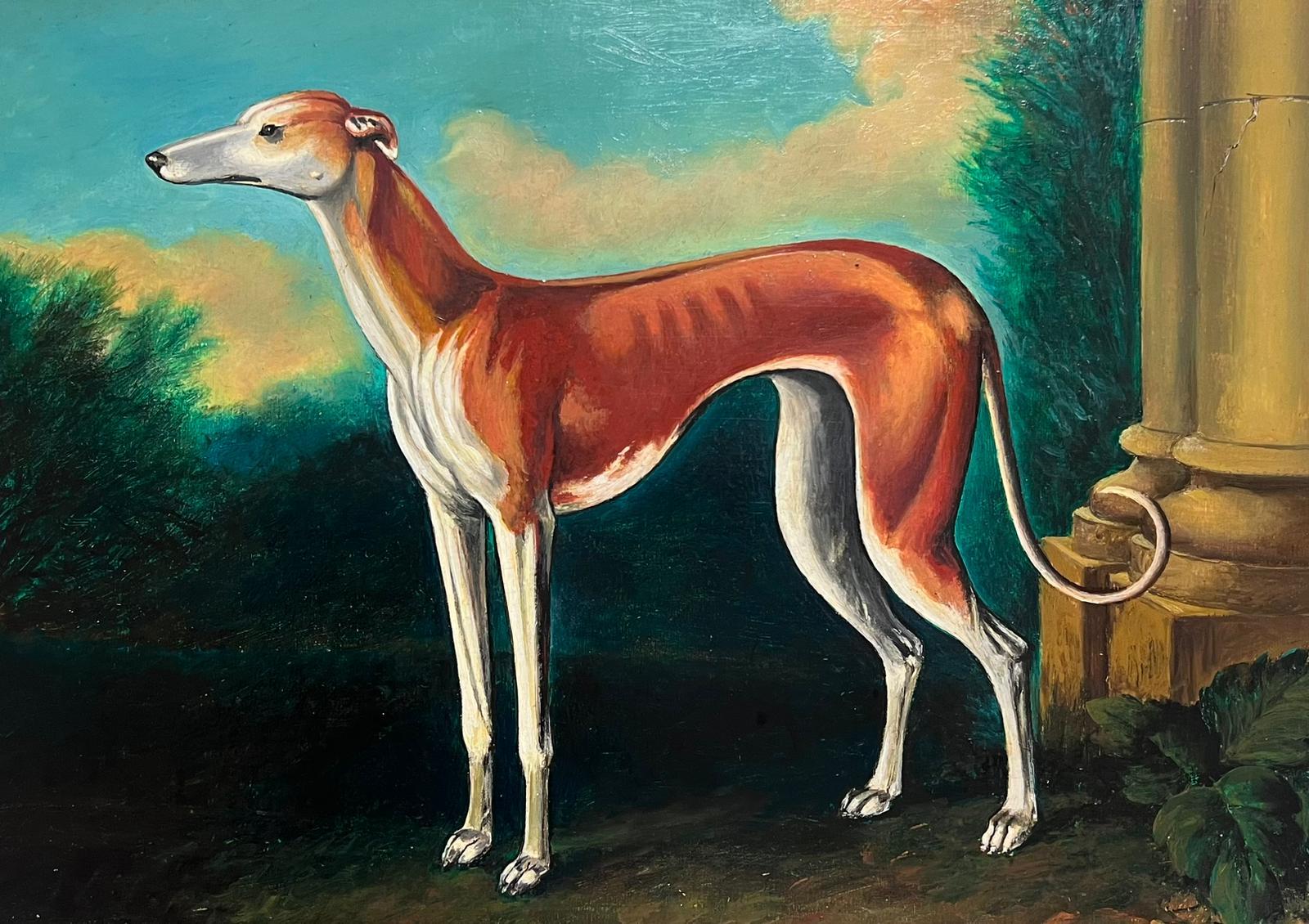Items Similar to Pastoral Scene with Shepherd and Animals - Old Master c 1700 art oil painting
Want more images or videos?
Request additional images or videos from the seller
1 of 16
Pastoral Scene with Shepherd and Animals - Old Master c 1700 art oil paintingCirca 1700
Circa 1700
About the Item
This superb Old Master later 17th/early 18th century oil painting is attributed to Baroque painter and German born animal artist Philipp Peter Roos. He was active in and near Rome from 1677 onwards and acquired the surname Rosa de Tivoli where he lived for many years. He was famous for painting exactly this sort of scene with a darker background, heavy brown tones and the animals highlighted and often silhouetted. He was known to keep a menagerie of animals so he could paint and draw from live poses. Painted circa 1700 the composition is a seated young shepherd and his dog with two handsome goats and a sheep. The shepherd is clearly the least important element for Roos, his back to us and silhouetted off to the left. In the immediate foreground is his dog which looks remarkably like a springer spaniel. Behind him is a sheep looking round and then two long horned goats, one white one black, on slightly higher ground, silhouetted against a dramatic sky. All the action is happening in the foreground, right in front of the viewer with a gradation in height. One feels one could almost touch the animals. A superb Old Master oil painting with lovely brushwork and detail.
Provenance. Sussex estate.
Condition. Oil on canvas, 24 inches by 24 inches unframed, in good condition.
Frame. Housed in a gilt frame 31 inches by 31 inches framed and in good condition.
Philipp Peter Roos (later surnamed Rosa di Tivoli; 1655–1706) was a German Baroque painter, active in and near Rome from 1677 onward. He was born in Frankfurt am Main and learned to paint from his father, the landscape painter Johann Heinrich Roos. He was the brother of the painter Johann Melchior Roos, who briefly worked with him in Italy. As a young man, he painted in the style of his father. He was called to paint for Charles I, Landgrave of Hesse-Kassel, who liked him so much he gave him a sum of money to travel to Rome with, which he did in 1677. In Rome, he worked often in the studio of Giacinto Brandi, and by 1681 had fallen in love with his daughter, for whom he converted to Catholicism and later married. In 1683, he joined a papal guild of painters, the Congregation of Virtuiosi al Pantheon. In 1684, he acquired a large house on Vicolo del Riserraglio in the Rione San Paolo in Tivoli, near Rome, whence his surname. In Tivoli, they kept a menagerie of various animals so Roos could draw from live poses. This house was called the "Noah's Ark" by their friends. In his Italian style, he painted life-size figures and animals in a broad manner and a heavy brown tone. In 1691, he moved back to Rome, where he was one of the Bentvueghels painters in the Schildersbent, a grouping of painters from the Low Countries. He had the nickname "Mercurius" because of the rapidity with which he painted; Mercury was the speedy messenger of Zeus.
- Attributed to:Philipp Peter Roos (Rosa di Tivoli) (1655 - 1706, German)
- Creation Year:Circa 1700
- Dimensions:Height: 31 in (78.74 cm)Width: 31 in (78.74 cm)Depth: 2 in (5.08 cm)
- More Editions & Sizes:31 inches by 31 inches.Price: $10,382
- Medium:
- Movement & Style:
- Period:1700-1709
- Condition:
- Gallery Location:London, GB
- Reference Number:1stDibs: LU853113277652
About the Seller
5.0
Platinum Seller
These expertly vetted sellers are 1stDibs' most experienced sellers and are rated highest by our customers.
1stDibs seller since 2018
402 sales on 1stDibs
Typical response time: 1 hour
- ShippingRetrieving quote...Ships From: London, United Kingdom
- Return PolicyA return for this item may be initiated within 14 days of delivery.
More From This SellerView All
- Italian Greyhound and Friends - Italian 17thC Old Master dog art oil paintingBy Francesco FieravinoLocated in London, GBThis stunning Old Master 17th century oil portrait painting is attributed to Francesco Fieravino, an artist famous in his day for still lifes and carpets. This painting which dates t...Category
17th Century Old Masters Animal Paintings
MaterialsCanvas, Oil
- Arcadian Italian Landscape - Old Master 17thC French oil painting herdsman sheepBy (Attributed to) Gaspard DughetLocated in London, GBA delicate oil on canvas landscape capriccio of an Arcadian landscape with figures and sheep and goats in the foreground. A stormy sky and blasted tree populate the landscape and the...Category
17th Century Old Masters Landscape Paintings
MaterialsOil
- Peacock and Birds in a Landscape - British 17thC Old Master animal oil paintingBy Marmaduke CradockLocated in London, GBThis stunning British Old Master oil painting is attributed to circle of noted bird painter Marmaduke Cradock. Painted circa 1690 it is an excellent example and the sort of collection of birds he loved to paint - a peacock, wild turkeys, a jay in the foreground and doves, all set in a beautiful landscape. A variant of this painting is now in The Tate collection. Unlike many artists, he preferred to paint live birds with all their passions, joys and quarrels. The artist has perfectly capture the dynamics between this group, especially the dove and jay, as they all begin to settle down in the twilight. The colouring and brushwork are superb making this a fantastic British Old Master bird oil painting in a stunning carved gilt frame. Provenance. London estate. Condition. Oil on canvas, 42 inches by 39 inches and in good condition. Frame. Housed in a magnificent complementary period carved and gilded frame, 50 inches by 47 inches and in good condition. Marmaduke Cradock (1660-1716) was an English painter of birds and animals. Some older sources give his first name as Luke. Cradock was an English painter, noted for his depictions of birds, dead game, and other animals. He was born in Somerton, Somerset and moved to London, where he served an apprenticeship to a house-painter. He was, however, self-taught as an artist, becoming skilled in the depiction of birds and animals. Horace Walpole wrote that "I have seen some pieces by his hand which he painted with a freedom and a fire that entitled them to more distinction". According to Walpole, Cradock deliberately shunned aristocratic patronage. He worked in general by the day, and for dealers who retailed his works; possessing that conscious dignity of talent which made him hate to be employed by men whose birth and fortune confined his fancy, and restrained his freedom. According to the RKD his work as a still life and bird painter was influenced by Melchior d'Hondecoeter, Peter Frans Casteels, and Jakob Bogdani. Sketches in the collection of the British Museum indicate that he based at least some of the birds in his paintings on drawings from life. He tended to paint domestic birds and common wild species, rather than the exotic varieties favoured by some other artists. He sometimes introduced elements of drama such as attacks by predatory animals into his bird paintings, a feature shared with the works of Francis Barlow...Category
17th Century Old Masters Animal Paintings
MaterialsOil
- Shepherd with Animals in Landscape - Dutch Old Master art pastoral oil paintingBy Nicolaes BerchemLocated in London, GBThis lovely Dutch Old Master oil painting is attributed to noted Dutch artist Nicholaes Berchem. Painted circa 1665 it is a charming pastoral scene of a shepherd and his animals including sheep, goats, donkey and cows and of course his trusty dog. They are all resting beneath trees while he looks on attentively. The light in the sky and the light and shadows on the animals is beautiful. A really superb example of Dutch Old Master art with great detail. Provenance. Surrey estate. Christies stamp verso. Condition. Oil on canvas, 38 inches by 32 inches and in good condition. Frame. Housed in a complementary gilt frame, 46 inches by 30 inches and in good condition. Nicolaes Pieterszoon Berchem (1620-1683) was a highly esteemed and prolific Dutch Golden Age painter of pastoral landscapes, populated with mythological or biblical figures, but also of a number of allegories and genre pieces. He was a member of the second generation of "Dutch Italianate landscape" painters. These were artists who travelled to Italy, or aspired to, in order to soak up the romanticism of the country, bringing home sketchbooks full of drawings of classical ruins and pastoral imagery. His paintings, of which he produced an immense number, (Hofstede de Groot claimed around 850, although many are misattributed), were in great demand, as were his 80 etchings and 500 drawings. His landscapes, painted in the Italian style of idealized rural scenes, with hills, mountains, cliffs and trees in a golden dawn are sought after. Berchem also painted inspired and attractive human and animal figures (staffage) in works of other artists, like Allaert van Everdingen, Jan Hackaert, Gerrit Dou, Meindert Hobbema and Willem Schellinks. Born in Haarlem, he received instruction from his father Pieter Claesz, and from the painters Jan van Goyen, Pieter de Grebber, Jan Baptist Weenix, Jan Wils and Claes Cornelisz. Moeyaert. According to Houbraken, Carel de Moor told him that Berchem got his name from two words "Berg hem" for "Save him!", an expression used by his fellows in Van Goyen's workshop whenever his father chased him there with the intent to beat him. No trip or Grand Tour by Berchem was documented by Houbraken though he mentioned another story about the "Berg hem!" nickname which came from Berchem's conscription as a sailor; the man in charge of impressment knew him and sent him ashore with the words "Save him!". Today his name is assumed to come from his father's hometown of Berchem, Antwerp. According to the RKD he traveled to Italy with Jan Baptist Weenix, whom he called his cousin, in 1642–5. Works by him are signed both as "CBerghem" and "Berchem". In 1645 he became a member of the Dutch reformed church and married the year after. According to Houbraken he married the daughter of the painter Jan Wils, who kept him on a short allowance, but to finance his collection of prints he would borrow money from his pupils and colleagues and pay them back from the proceeds of paintings that he didn't tell her about. Around 1650 he travelled to Westphalia with Jacob van Ruisdael, where a dated piece showing Burg Bentheim is recorded. Maybe Berchem went to Italy after this trip and before he moved to Amsterdam - he is not clearly documented in the Netherlands between 1650 and 1656. Around 1660 he worked for the engraver Jan de Visscher designing an atlas. In 1661-1670 he is registered in Amsterdam and in 1670 he moved back to Haarlem, but was living back in Amsterdam by 1677, where he died in 1683. He was a popular teacher and his pupils were Abraham Begeyn, Johannes van der Bent, his son Nicolaes, Isaack Croonenbergh, Simon Dubois, Karel Dujardin, Johannes Glauber, Pieter de Hooch, Jacob van Huchtenburg, Justus van Huysum...Category
17th Century Old Masters Landscape Paintings
MaterialsOil
- The Infant St John the Baptist with Lamb - Italian Old Master art oil paintingLocated in London, GBThis beautiful 18th century Italian Old Master oil painting is something rather special. Painted circa 1750 the subject matter is Saint John the Baptist as a very young child. He is ...Category
1750s Old Masters Portrait Paintings
MaterialsOil
- Still Life with Game, Fruit and Veg - Flemish 17thC Old Master art oil paintingLocated in London, GBPieter Boel, Flemish Old Master, painted this stunning 17th century still life oil painting. Painted circa 1660 it is a large and impressive still life with dead game surrounded by f...Category
17th Century Old Masters Still-life Paintings
MaterialsOil
You May Also Like
- Enormous French Oil Painting King Louis XIV of France on HorsebackBy Pierre MignardLocated in Cirencester, GloucestershireFrench School, after Pierre Mignard Louis XIV on Horseback oil on canvas, unframed painting: 60 x 41 inches provenance: private collection, UK The paint...Category
20th Century Old Masters Figurative Paintings
MaterialsOil, Canvas
- 17th century Italian Horse Battle scene between Crusaders and their enemyBy Jacques CourtoisLocated in Woodbury, CTFine huge 17th Century Italian/French Old Master Battle Scene of the Crusades, oil on canvas. Grand scale extensive landscape view of a battle from the 1670-80 period, with cavalry f...Category
Late 17th Century Old Masters Figurative Paintings
MaterialsOil
- 19th century English portrait of a White/grey hunter in a stableBy Charles TowneLocated in Woodbury, CTEnglish 19th century portrait of a White / Grey hunter in a stable. Charles Towne was born in Wigan in 1763. He was trained as a coach painter, and by ...Category
1820s Old Masters Animal Paintings
MaterialsOil, Canvas
- 18th century portrait of a Spaniel dog with fruit in a wooded landscape.By Tobias StranoverLocated in Woodbury, CTOutstanding early 18th-century portrait of a seated Spaniel dog in a landscape with an array of fruits. Attributed to the work of Tobias Stranover. ...Category
1730s Old Masters Animal Paintings
MaterialsOil
- Whippet Greyhound in Classical Landscape Fine British Dog Painting in OilLocated in Cirencester, GloucestershireWhippet in Classical Landscape Michael Constable (20th Century British School) oil on board, framed framed: 19 x 25 inches board: 15 x 21 inches provenance: private collection, The C...Category
Late 20th Century Old Masters Animal Paintings
MaterialsOil
- A dark bay racehorse held by his trainer at Newmarket HeathLocated in Stoke, HampshireBenjamin Killingbeck (act. 1769-1783) A dark bay racehorse held by his trainer on a racecourse Oil on canvas Canvas Size - 40 x 50 in Framed Size ...Category
18th Century Old Masters Animal Paintings
MaterialsOil
Recently Viewed
View AllMore Ways To Browse
Antique Animal
Antique Animal Art
Old Large Painting
Old Young Paintings
Old House Paintings
Large Old Master
Old Masters Painters
Oil Painting Old Master
Animal Figures
Old Antique Oil Paintings
Painting Old German
Old Man Painting
Painting The Old Man
Old Master Scene
Antique 1700
Large Oil Painting Masters
Large Old Oil Paintings
Large Old Master Italian





